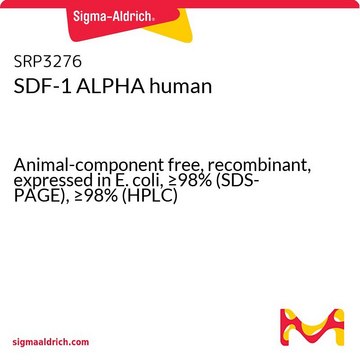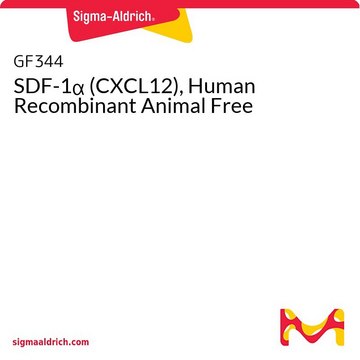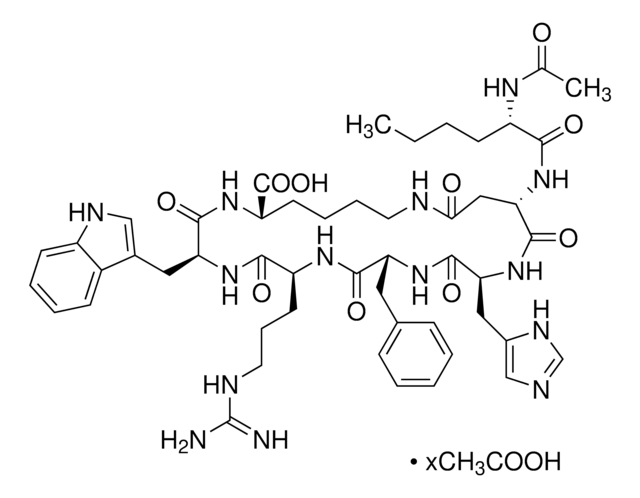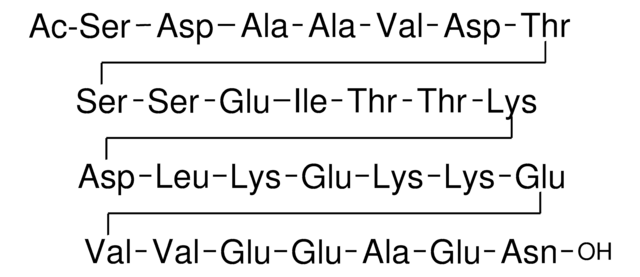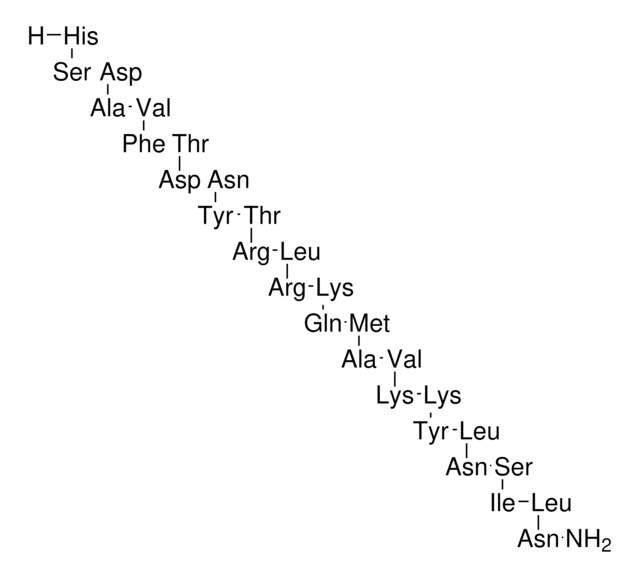推荐产品
生物源
human
重組細胞
expressed in E. coli
化驗
≥95% (HPLC)
≥95% (SDS-PAGE)
形狀
lyophilized
效力
0.5-10 μg/mL
分子量
5.2 kDa
包裝
pkg of 100 μg
雜質
endotoxin, tested
UniProt登錄號
運輸包裝
wet ice
儲存溫度
−20°C
基因資訊
human ... TMSB4X(7114)
一般說明
Thymosin-β4 is a small, actin-sequestering protein belonging to the thymosin-β family that is found at high concentrations within the spleen, thymus, and peritoneal macrophages, where it is most notably responsible for the organization of cytoskeletal structure. Commonly found at significant quantities within the brain, lungs, liver, kidneys, testes, and heart, Thymosin-β4 has also been shown to be synthesized by cells unrelated to the reticuloendothelial system, such as myoblasts and fibroblasts, and expressed at irregular levels by several hemopoietic cell lines, malignant lymphoid cells and myeloma cells. The gene is mapped to human chromosome Xq21-22. Recombinant Human Thymosin-β4 is a 5.2kDa glycoprotein containing 45 amino acid residues.
生化/生理作用
In mammalian tissues, thymosin-β4 protein acts as a modulator for the polymerization/depolymerization of actin through the formation of a 1:1 complex with the monomer G (globular)-actin, and inhibits actin′s polymerization to form F (filamentous) actin, which together with other proteins binds microfilaments to construct the cytoskeleton. In addition to regulating actin polymerization, research has also found thymosin-β4 to stimulate the secretion of hypothalamic luteinizing hormone-releasing hormone and luteinizing hormone, inhibit the migration of peritoneal macrophages, induce phenotypic changes in T cell lines during early host defense mechanisms, and inhibit the progression of hematopoietic pluripotent stem cells into the S-phase. It also enhances angiogenesis, endothelial cell migration and adhesion and tubule formation. Thymosin-β4 also participates in wound healing by reducing inflammation and by exhibiting anti-fibrotic effects. It also controls the migration of cancer cells.
外觀
Lyophilized with no additives.
重構
Centrifuge the vial prior to opening. Reconstitute in water to a concentration of 0.1-1.0 mg/ml. Do not vortex. This solution can be stored at 2-8 °C for up to 1 week. For extended storage, it is recommended to further dilute in a buffer containing a carrier protein (example 0.1% BSA) and store in working aliquots at -20 °C to -80 °C.
儲存類別代碼
11 - Combustible Solids
水污染物質分類(WGK)
WGK 3
閃點(°F)
Not applicable
閃點(°C)
Not applicable
The actin-sequestering protein thymosin beta-4 is a novel target of hypoxia-inducible nitric oxide and HIF-1a regulation.
Ryu YK, et al.
PLoS ONE, 9, e106532-e106532 (2014)
Thymosin ?4-sulfoxide attenuates inflammatory cell infiltration and promotes cardiac wound healing.
Evans MA, et al.
Nature Communications, 4, 2081-2081 (2013)
The actin binding site on thymosin beta4 promotes angiogenesis.
Philp D, et al.
Faseb Journal, 17, 2103-2105 (2003)
Alexander Belyy et al.
Nature communications, 12(1), 6628-6628 (2021-11-18)
Bacterial human pathogens secrete initially inactive nucleotidyl cyclases that become potent enzymes by binding to actin inside eukaryotic host cells. The underlying molecular mechanism of this activation is, however, unclear. Here, we report structures of ExoY from Pseudomonas aeruginosa and
beta-Thymosins, small acidic peptides with multiple functions.
Huff T, et al.
The International Journal of Biochemistry & Cell Biology, 33, 205-220 (2001)
我们的科学家团队拥有各种研究领域经验,包括生命科学、材料科学、化学合成、色谱、分析及许多其他领域.
联系技术服务部门
